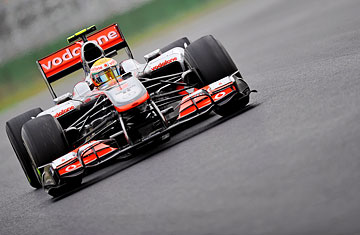
British racer Lewis Hamilton takes part in Formula One's Korean Grand Prix on Oct. 23, 2010. The two-year-old South Korean event is struggling to attract fans
Racing fans bask in the sun on a sweltering summer day, drinking beer and watching Formula One stars like Sebastian Vettel and Lewis Hamilton swerve along the track hugging the shoreline at speeds up to 200 m.p.h. (320 km/h). It sounds like a typical racing day at Formula One's premier track in Monte Carlo, but this is no Monaco. In the background, across the river, are the glittering skyscrapers of Manhattan.
Formula One is not only making a return to the U.S.; the world's most popular motor sport announced recently that it is coming to America's most international city and largest sports market: New York. A longtime goal of Bernie Ecclestone, the eccentric 81-year-old Formula One boss, the race will actually be set across the Hudson River in New Jersey, running along the water through Weehawken and West New York, starting in 2013. But with Manhattan as a backdrop, it promises to be every bit as glamorous as the Grand Prix of Monaco and the Singapore Grand Prix. This isn't the only trick up Ecclestone's sleeve — a second U.S. Grand Prix is being added to the schedule next year in Austin as well.
Given Formula One's tortured past in the U.S. and relatively small American fan base, bringing not just one but two Grand Prix events back to the country is an audacious move. Indianapolis hosted the last U.S. Grand Prix from 2000 to '07, but after Formula One pulled out due to a conflict with the Indianapolis Motor Speedway over the financial terms for the event, Ecclestone vowed he would "never" return to the city. (The race also suffered a p.r. disaster in 2005 when only six cars took part because of concerns over tire safety.) Other cities have previously hosted Formula One races, but the sport never managed to gain a consistent foothold domestically, partially due to its rivalry with NASCAR and IndyCar, coupled with the staggering financial investment required to host an event. "Staging Formula One is incredibly expensive," says Mario Andretti, one of only two American drivers ever to win the F1 World Drivers Championship. "[But] if you know that going in, then you've got a chance. If you go in with eyes closed, you're doomed to failure. That's what we've seen in the past."
The announcement last year that Austin, a city known more for its independent art and music scene than for motor sports, would host a new version of the U.S. Grand Prix came as a surprise to F1 fans and residents alike. Concerns began to emerge almost immediately. With the race scheduled to make its debut in 2012, Austin organizers have quickly been building an all-purpose, privately funded track for the event, estimated to cost between an eye-popping $250 million and $300 million. The state of Texas has also drawn criticism for using taxpayer funds to cover the sanction fee it must pay to F1's managing body — about $250 million over a period of 10 years.
The New Jersey race looks to be far less controversial. For one, the Grand Prix of America, as the event will be known, will be run on existing streets, eliminating the need for a new track. And instead of tapping into taxpayer dollars to pay for the event, the race will be funded solely by private investors. Leo Hindery Jr., the investment firm magnate who is putting together the financial backing, sought to differentiate between the two races during a press conference on Oct. 25 in New Jersey. "There's not a yard of dirt being moved [in New Jersey]. We're pennies on the dollar compared to Austin." He also pointed out that Austin's mounting costs could be a hindrance to the event's long-term survival. "I wouldn't bet on Austin making it," Hindery said.
Some fans, however, say the biggest obstacle to F1's success in the U.S. isn't money, but the fact there isn't a single American driver on the F1 circuit. Scott Speed was last American driver to race for an F1 team in 2007. And Andretti's championship went way back in 1978. Skeptics point to Turkey as the poster child for what happens when a local driver isn't on the track: the Turkish Grand Prix has suffered from poor attendance in recent years and was finally dropped from the F1 calendar in 2012. The Korean Grand Prix, only two years old, has also struggled to attract fans — in part due to a lack of a Korean F1 driver — and has suffered big losses financially. Spanish driver Pedro de la Rosa said last year that having a homegrown driver in the field is crucial to a race's success. "I don't think the area is so important, but you need an American driver. More important is, Where are you going to find an American driver?" he said.
But Vance Facundo, an Austin resident who was astounded when he discovered the new F1 track was being built mere minutes from his backyard, believes it will just take time to develop a fan base in the U.S. He's grown to like F1 over the past year, despite preferring NASCAR in the past, and now runs a Facebook fan page devoted to the Austin event. To him, the race isn't just about the cars — he thinks it could have a huge economic impact on his city as well. "The area that I live in, we don't have a lot of infrastructure, we don't have a lot of high-paying jobs, anything like that," he tells TIME. "So this [circuit] was something I really wanted to support in order to make sure it happened."
Erica Ho is a reporter at TIME. Find her on Twitter at @ericamho and Google+. You can also continue the discussion on TIME's Facebook page and on Twitter at @TIME.
